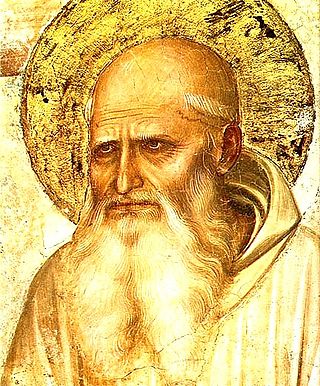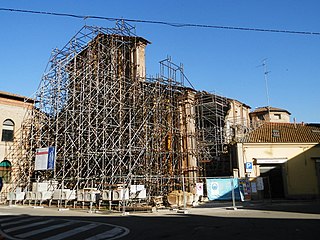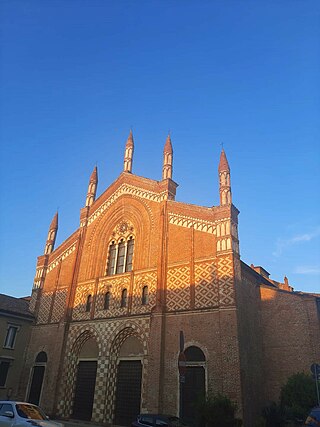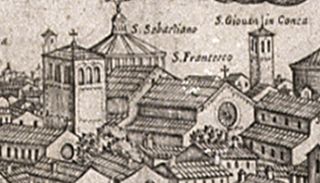
Assisi is a town and commune of Italy in the Province of Perugia in the Umbria region, on the western flank of Monte Subasio.

The Archbasilica of Saint John Lateran is the Catholic cathedral of the Diocese of Rome in the city of Rome, and serves as the seat of the bishop of Rome, the pope. The only "archbasilica" in the world, it lies outside of Vatican City proper, which is located approximately four kilometres northwest. Nevertheless, as properties of the Holy See, the archbasilica and its adjoining edifices enjoy an extraterritorial status from Italy, pursuant to the terms of the Lateran Treaty of 1929. Dedicated to the Christ, in honor of John the Baptist and John the Evangelist, the place name, Laterano (Lateran) comes from an ancient Roman family (gens), whose palace (domus) grounds occupied the site; the adjacent Lateran Palace was the primary residence of the pope until the Middle Ages.

Baroque architecture is a highly decorative and theatrical style which appeared in Italy in the late 16th century and gradually spread across Europe. It was originally introduced by the Catholic Church, particularly by the Jesuits, as a means to combat the Reformation and the Protestant church with a new architecture that inspired surprise and awe. It reached its peak in the High Baroque (1625–1675), when it was used in churches and palaces in Italy, Spain, Portugal, France, Bavaria and Austria. In the Late Baroque period (1675–1750), it reached as far as Russia, the Ottoman Empire and the Spanish and Portuguese colonies in Latin America. In about 1730, an even more elaborately decorative variant called Rococo appeared and flourished in Central Europe.

Romuald was the founder of the Camaldolese order and a major figure in the eleventh-century "Renaissance of eremitical asceticism". Romuald spent about 30 years traversing Italy, founding and reforming monasteries and hermitages.

The Basilica of Saint Francis of Assisi is the mother church of the Roman Catholic Order of Friars Minor Conventual in Assisi, a town in the Umbria region in central Italy, where Saint Francis was born and died. It is a papal minor basilica and one of the most important places of Christian pilgrimage in Italy. With its accompanying friary, Sacro Convento, the basilica is a distinctive landmark to those approaching Assisi. It has been a UNESCO World Heritage Site since 2000.

The church of San Carlo alle Quattro Fontane, also called San Carlino, is a Roman Catholic church in Rome, Italy. The church was designed by the architect Francesco Borromini and it was his first independent commission. It is an iconic masterpiece of Baroque architecture, built as part of a complex of monastic buildings on the Quirinal Hill for the Spanish Trinitarians, an order dedicated to the freeing of Christian slaves. He received the commission in 1634, under the patronage of Cardinal Francesco Barberini, whose palace was across the road. However, this financial backing did not last and subsequently the building project suffered various financial difficulties. It is one of at least three churches in Rome dedicated to San Carlo, including San Carlo ai Catinari and San Carlo al Corso.

St. George's Basilica or the Basilica and Collegiate Parish Church of Saint George, also simply known as San Ġorġ in Maltese, is a historic Baroque church situated in the middle of Gozo, the second largest island in the Maltese archipelago, and is surrounded by a maze of old narrow streets and alleys. The church had been rebuilt numerous times during the Middle Ages. Today's basilica was built between 1672 and 1678.

San Francesco della Vigna is a Roman Catholic church in the Sestiere of Castello in Venice, northern Italy.

Isidoro Bianchi called da Campione was an Italian painter of the Baroque period.

Bolzaneto is a quarter of the city of Genoa, in northwest Italy, and is part of the Municipality Valpolcevera of Genoa.

The Basilica di San Pietro di Castello, commonly called San Pietro di Castello, is a Roman Catholic minor basilica of the Patriarch of Venice located in the Castello sestiere of the Italian city of Venice. The present building dates from the 16th century, but a church has stood on the site since at least the 7th century. From 1451 to 1807, it was the city's cathedral church, though hardly playing the usual dominant role of a cathedral, as it was overshadowed by the "state church" of San Marco and inconveniently located. During its history, the church has undergone a number of alterations and additions by some of Venice's most prominent architects. Andrea Palladio received his first commission in the city of Venice from the Patriarch Vincenzo Diedo to rebuild the facade and interior of St Pietro, but Diedo's death delayed the project.
San Marino is a small landlocked country with an area of about 61.2 km2 (23.6 sq mi) on a rocky promontory at an elevation of 657 meters (2,156 ft) in central Italy. In 2023, the population was 33,636. It is the third smallest country in Europe after Vatican City and Monaco. It is traditionally held to have been founded as a republic in 301 AD, was recognized by the Papacy in 1631, and became a member of the United Nations in 1992. As of 2009, the ethnic composition was about 84.95% Sammarinese, 14.6% Italians and others.

Santa Maria delle Grazie alle Fornaci fuori Porta Cavalleggeri is a Baroque style, Roman Catholic parish and titular church located at Piazza di Santa Maria alle Fornaci, south of Vatican City and north of the San Pietro train station in the Aurelio quarter. It was made a cardinalate deaconry by Pope John Paul II on 25 May 1985, and assigned it to Cardinal Duraisamy Simon Lourdusamy, then Prefect of the Congregation for the Oriental Churches. The church became vacant on 2 June 2014 after the death of Cardinal Lourdusamy. On November 11, 2016 it was announced that Mario Zenari will succeed him.

Pietro Francesco Carlone, or Peter Franz Carlone, from the Leoben branch of the Carlone family, was an early Baroque architect who was best known for building abbeys.

The Basilica of Santa Maria in Porto was an important church in Ravenna, not far from Porta Nuova, on the via Roma, the north–south high street across the historic city centre. It houses the Greek Madonna.

The Tomb of Dante is an Italian neoclassical national monument built over the tomb of the poet Dante Alighieri (1265-1321) in 1781. It is sited next to the Basilica of San Francesco in central Ravenna.

The church of San Francesco is a church located in Mirandola, in the province of Modena, Italy.

The church of San Francesco of Assisi is a Catholic religious building in Pavia, Lombardy, Italy.

The Church of San Francesco Grande was an ancient church in Milan built in the 4th century and demolished in 1806. It was originally called Basilica di San Nabore after the saint whose remains it houses, but from the 13th century onwards, as the adjoining Franciscan monastery took possession of the monument, it took its new name from Francis of Assisi, founder of the order.

The city of Vicenza is extremely rich in churches, monasteries, convents and other buildings intended for worship or religious activities, built during the seventeen centuries of Christian presence in the city.



















